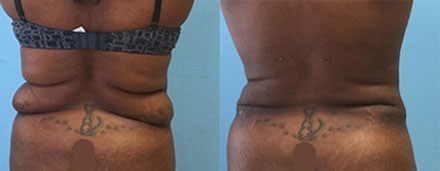A hair transplant procedure is a minimally invasive procedure to relocate healthy hair follicles to balding or thinning areas of the head.
While many other hair restoration solutions offer minimal results, if any, hair transplants use individual grafts of a patient’s own live follicles which are transferred during a process called follicular unit extraction (FUE). This process safely and effectively allows for natural regrowth of the patient’s hair in the desired area. For those interested in the hairline of their younger days, Dr. Saira Saini is proud to introduce two new hair transplantation devices: The ARTAS System and NeoGraft. These two advanced technologies can improve receding hairlines, and eliminate bald spots with the patient’s own hair follicles. If you have noticed balding or thinning areas around your head, please don’t hesitate to schedule a consultation at our Fayetteville offices. Hair loss can be treated more effectively when caught in the earlier stages. To reach us directly, call our front desk at (910) 323-1234.
About
Quick, run your hand through your hair. Don’t pull hard. Just lightly pass your fingers through from the root to the ends. Now, look at your hand. Are there hairs interwoven between your fingers? Count them. Are there less than three or more than six? What you just did was a pull test: a rudimentary DIY examination of your follicular health. In your pull test, if you counted less than three hairs, you receive a negative score (no concern for hair loss). If, however, you pulled more than six, you receive a positive score (a sign you should consult with a hair restoration specialist).[1] For men of both parties, the ones rejoicing and the ones currently fretting, it is important to note that 85% of men experience some degree of alopecia (hair loss) by their 50th birthday and 25% of those men have been balding since they were 21.[2] Likewise, 40% of women experience hair loss to varying extents throughout their lives.[3] So, those who pulled six or more hairs shouldn’t feel embarrassed or alone in this, but rather know that hair loss is more likely to happen during your lifetime than not, and those that pulled three or fewer shouldn’t stake their fortune on their luscious locks just yet.
Hair Restoration: FUT vs. FUE
Traditional hair restoration methods include follicular unit transplantation (FUT). This method, born in the 1990s, involves making a linear incision along the back of the head. Then, the medical professional extracts the hair follicles from the excised strip of skin. They then relocate these healthy follicles to any bald or receding areas. While this method has provided many patients with remarkably natural results, their hair is limited in terms of style and cut after the treated areas fully heal. The long incision along the back of the head creates a noticeable scar that stands out with any short hairstyle. So, while it produces adequate results, the demand remained for a scarless hair transplant technique. That is where FUE enters the conversation.
FUE uses advanced technology to surgically remove healthy follicles from thicker donor areas to then relocate them to balding areas. FUE does not require a long scar on the back of the head and is now seen as the “dream” technique by hair restoration specialists.[3]
Saini’s Hair Transplant Procedures
For those interested in seeing how FUE hair restoration can help restore your hairline, the first step is to schedule a consultation with Dr. Saini. She will be able to answer any questions, examine your hair loss, and explain the technology available for your hair restoration procedure.
The ARTAS System
The ARTAS System is an FUE hair restoration device that robotically extracts, prepares, and relocates the follicles. First, the software maps out the patient’s follicular units with a system of cameras and computer software. Next, it uses a robotic arm to make very small, 1 mm-sized punches in the determined donor areas to excise the follicles.[5] The ARTAS software evenly spaces out the grafts during removal and placement, so it can then systematically transplant the follicles into the balding or thinning areas for consistent and natural-looking coverage. Thus restoring a natural hairline with no scar.
NeoGraft
NeoGraft is a handheld device that extracts hundreds of hair follicles from donor sites and then precisely transplants them into thinning places around the scalp. We first numb the target areas. Then, we use the NeoGraft device to extract the necessary amount of hair follicles. The NeoGraft device has a highly specialized pneumatic arm that implants the follicles into the desired area(s). NeoGraft is perfect for smaller areas like the temples and widow’s peak.
Benefits
As opposed to FUT methods, ARTAS and NeoGraft come with two distinct advantages.
[pg-promo slug=”laser-cap-hair-restoration”]
No Scarring
When the FUE devices surgically remove the healthy hair follicles from the harvest areas, they don’t leave scarring. Opposed to the linear scar left from FUT methods, FUE is ideal for patients who wear their hair short and don’t want any noticeable scarring after they’ve fully healed from their hair transplantation procedure. There is no way to tell that you had hair restoration procedure. You will have natural hair that is yours but now relocated to an area on your scalp where it can most benefit your appearance.
Naturally Regrown Hair
Unlike other hair loss options, like wigs, toupees, and messy sprays, ARTAS and NeoGraft use your own natural hair follicles to regrow your hair. So, you don’t have to worry about finding the right shade of your natural hair color or the right texture of wigs. Also, ARTAS and NeoGraft use advanced technology to evenly space out the transplanted follicles, relocating them at optimal depths in the scalp. These features are important because they allow the hair to regrow uniformly and in line with your natural characteristics. The robotic precision also eliminates any damage to surrounding hair follicles.
Am I a Candidate for Hair Transplants?
For those interested in hair restoration at Carolina Plastic Surgery, here’s a list of qualifications.
Qualifications for Hair Restoration Patients
- Balding or thinning hair on top of their head
- Abundant, healthy follicles in donor areas (sides and back of the head)
- Tried previous hair restoration treatments with little to no success
- Accurate expectations for recovery and results
Personal Consultation
Dr. Saini is a board-certified plastic surgeon who has helped hundreds of patients achieve their desired aesthetic appearance. During your consultation at our Fayetteville offices, Dr. Saini will examine your hair loss and note the areas that appear to be thinning. Next, she will explain how ARTAS and NeoGraft work to promote a healthier head of hair. She will determine what is best for you and your cosmetic goals. Once we schedule your appointment, we will give you a list of preparatory steps. Please follow these in the interim to ensure optimal results.
Preparation
When preparing for hair transplantation, it is best to follow these steps during the weeks before your procedure.
- Avoid nicotine as it constricts blood vessels and hampers the body’s natural healing abilities.
- Avoid blood-thinning medications such as ibuprofen, aspirin, or NSAIDs as these will cause excessive bleeding throughout your procedure.
- For some patients, we will ask that you have shorter hair in the donor areas as this will allow easier access during the extraction phase of the procedure.
- Have a light breakfast on the day of your procedure.
- Designate a caregiver to drive you home following your hair transplantation.
Recovery
During the procedure, we only utilize a local or topical anesthetic, and some oral medications so you will be awake and able to go home that same day. Your scalp will be swollen and tender for 1-2 days. It is best to avoid strenuous activities during this time and focus solely on recovering. Be sure not to wear anything on your head. This includes hats and hoods. Also, avoid rubbing or scratching your head as this may aggravate the relocated follicles.
Results
A few weeks after your hair transplant, be aware that the implanted follicles will fall out. This is completely normal and is evidence that the procedure has taken effect. Over the next 8-12 months, the follicle will produce new growth of healthy hair, and you will enjoy a thicker coverage of hair in the treated areas.
Cost
The cost of your hair transplants will depend on the number of grafts to be transplanted and the other details included in your personalized treatment plan. During your consultation, Dr. Saini and her staff will discuss pricing and the cost of your personalized procedure. For those interested in financing their hair transplant procedure, click here to check out our financing options. Also, be sure to stay up to date on our specials as they change periodically. If you have any questions, don’t hesitate to call our front desk at (910) 323-1234.
References
- Vidal C. I. (2015). Overview of Alopecia: A Dermatopathologist’s Perspective. Missouri medicine, 112(4), 308–312. https://www.ncbi.nlm.nih.gov/pmc/articles/PMC6170065/
- American Hair Loss Association – Men’s Hair Loss / Introduction. (2021). Americanhairloss.org. https://www.americanhairloss.org/men_hair_loss/introduction.html
- Zito PM, Raggio BS. Hair Transplantation. [Updated 2021 Jul 25]. In: StatPearls [Internet]. Treasure Island (FL): StatPearls Publishing; 2021 Jan-. Available from: https://www.ncbi.nlm.nih.gov/books/NBK547740/
- Dua, A., & Dua, K. (2010). Follicular unit extraction hair transplant. Journal of cutaneous and aesthetic surgery, 3(2), 76–81. https://doi.org/10.4103/0974-2077.69015
- Chan, D., & Ducic, Y. (2015). Citation: Chan D, Ducic Y. An Update on Hair Restoration. J Aesthet Reconstr Surg, 1(1), 1. https://doi.org/10.4172/2472-1905.10008






